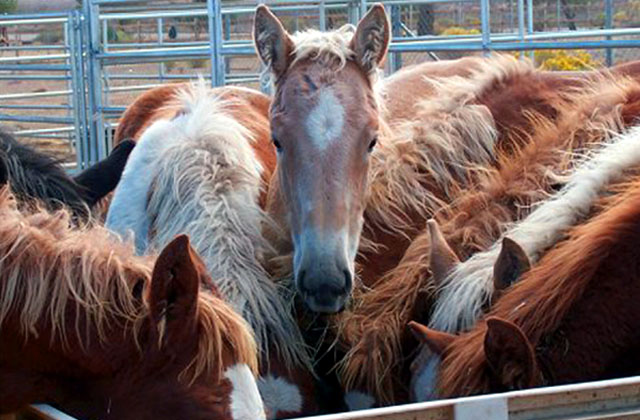PMU stands for “pregnant mare’s urine”. The urine of pregnant mares is used in the manufacturing of Premarin the female hormone replacement. This industry is located mostly in Canada, in the region of Manitoba, close to the Wyeth-Ayerst pharmaceutical company who manufactures Premarin. Since research has proven that Premarin causes cancer in women, there has been a decline in production of the hormone. Consequently, over the last few years over 300 PMU ranches have been closed. Only 70 are still in operation.
PMU ranchers usually chose a specific type of horse to breed, as they have to keep so many mares pregnant in order to collect the urine. Foals are a by-product of this business, so they might as well be foals that can be sold. Some PMU ranchers treat this as a breeding business, as well as a urine production business. So when the decision to close is made, many mares (and foals) are in need of adoptive homes. Slaughter is still legal in Canada, so there is always the fear of these horses going to slaughter if they cannot find adoptive homes.
When we think of the hundreds of uses horses have had through the centuries, and work they continue to do today, we do not always think of the thousands of mares working right now for drug companies. The job is for mares to be pregnant and produce hormones that can be collected for use in certain drugs. The hormones are used for hormone replacement therapy drugs that in humans are believed to relieve symptoms of menopause and control osteoporosis. The Premarin® Family of drugs is a lucrative and ever-expanding category of drugs derived from conjugated equine estrogens (CEE) which are collected from pregnant mare urine. Although health risks have been associated with the drugs and plant-based alternatives are available, the horse-derived hormone collection remains a large industry, with the number of mares in a year ranging from the thousands to tens of thousands, based on drug demand.
What is the job like for a Premarin mare? While a mare is in the production, or pee, line she stands in an enclosure so small that natural movement is not possible. She is fitted with a urine collection bag, and stands, sometimes full-time, for six months of each year. The mare is allowed to eat, but water intake is limited in order to concentrate the urine.[/span4]
In spring, the mare is released to pasture to give birth. She is allowed to spend the summer with her foal, but after the first frost of fall, she is separated from the foal. If the mare produces urine well and can be impregnated again, she will return to the pee line. Otherwise, she is either sent to slaughter for sale in Europe or Asia for human consumption, or if she is lucky, she may be purchased at auction to be rescued and adopted.
And what happens to her foal? It may either be incorporated into the pee line itself, it may be fattened for slaughter, or, with luck, it may be adopted.
